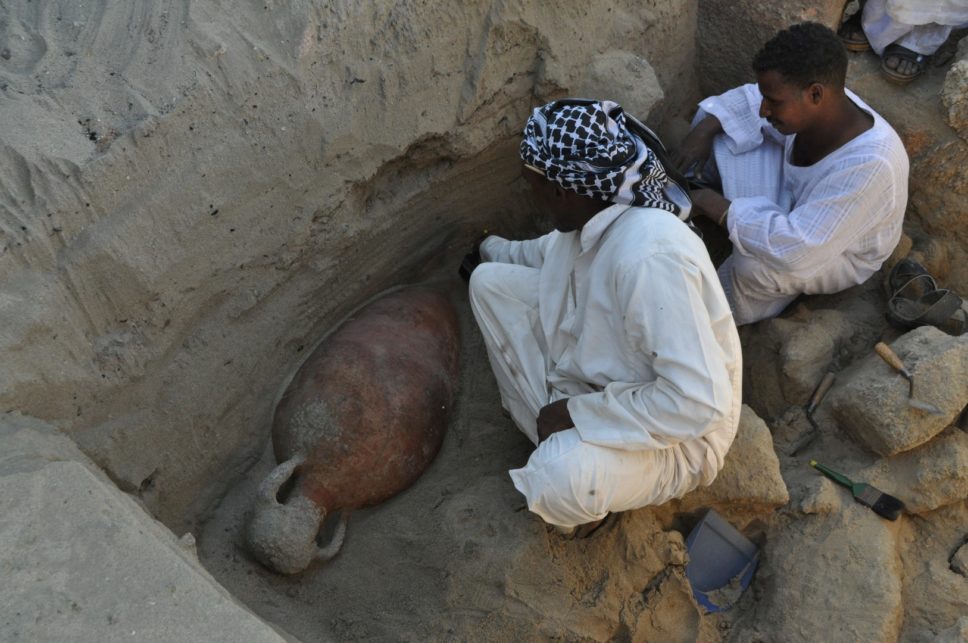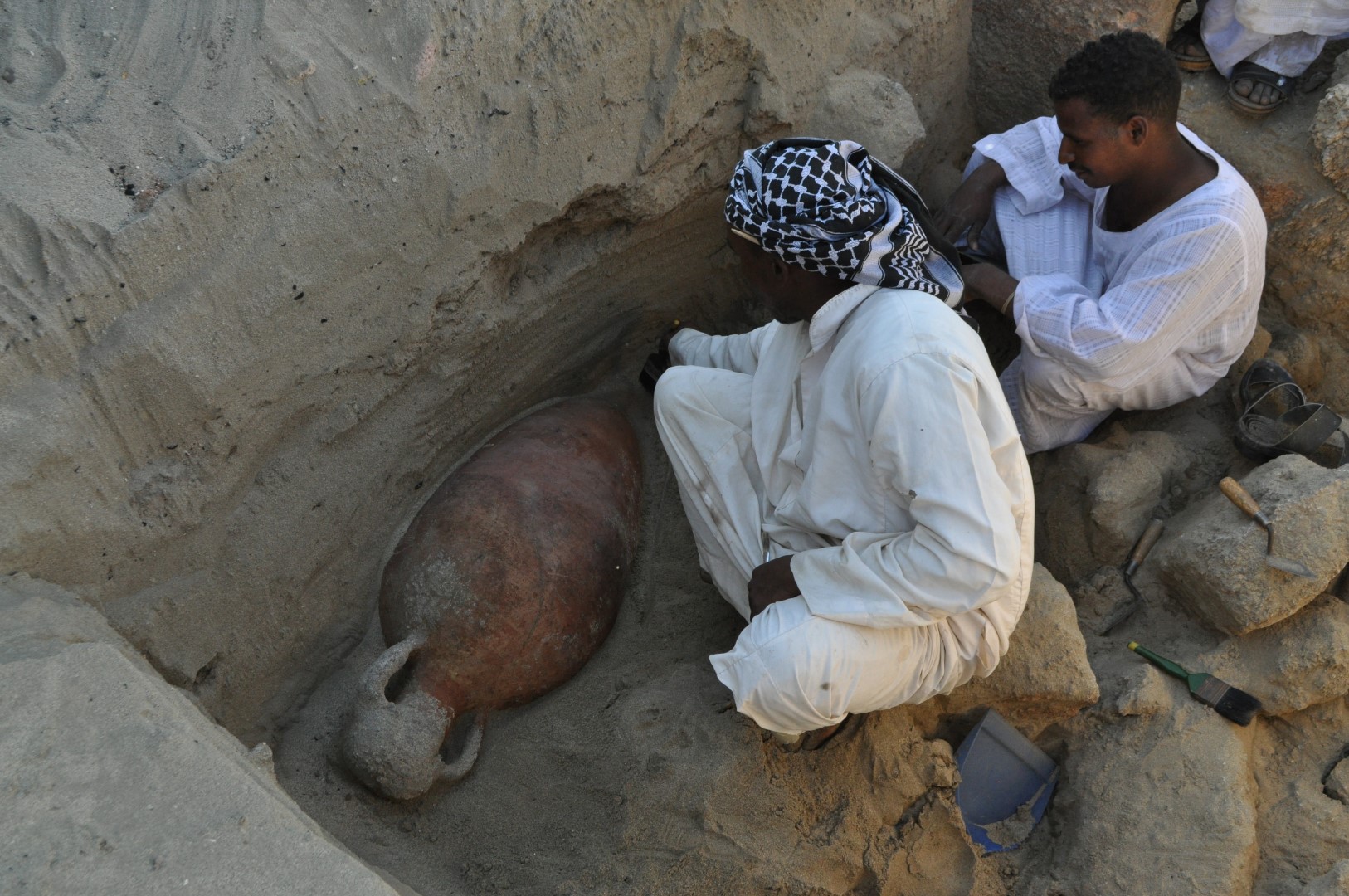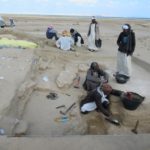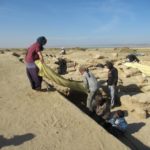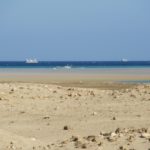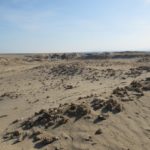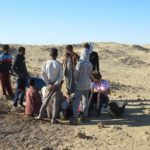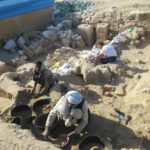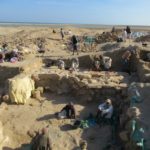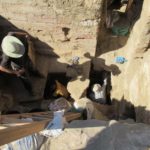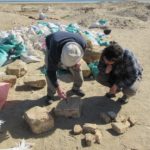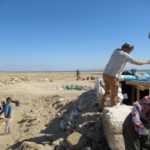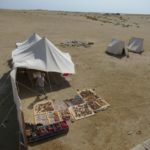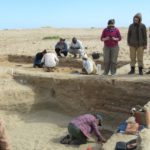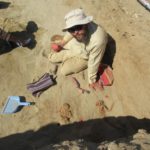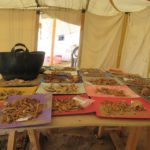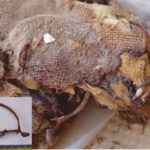Berenike
Berenike, Barnis (nazwy współczesne)
Berenike (Βερενίκη), Berenike Troglodytica (nazwa grecka)
Berenice (łacińska, używana szczególnie po angielsku i w odniesieniu do miasta rzymskiego)
-
Nazwa projektu:
The Berenike Project
Polsko-amerykańska misja archeologiczna w BerenikeLogo projektu:
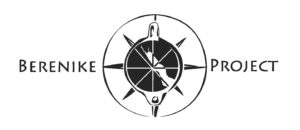
Strona i media społecznościowe:
-
Typ stanowiska:
Osadnicze – miasto portowe, nekropola
Lokalizacja:
Egipt
Wybrzeże Morza Czerwonego
Pustynia WschodniaDatowanie:
– okres hellenistyczny (połowa III wiek p.n.e.–I wiek p.n.e.)
– okres wczesno rzymski-rzymski (I–III wiek n.e.)
– okres późnorzymski/późnoantyczny (późny IV wiek p.n.e.–poł. VI wieku n.e.)
Najciekawsze odkrycia:
– hellenistyczne fortyfikacje (fort i mury obronne miasta)
– hellenistyczne podziemia (zbiorniki na wodę, tunel)
– kilka budynków świątynnych i kościół
– ośmiokilogramowa ofiara z czarnego pieprzu w indyjskich dzbanach znaleziona przy Wielkiej Świątyni – znalezisko, które udowodniło kontakty Afryki Wschodniej z Indiami
– zbiór tekstów na papirusach i ostrakonach
– 11 poświadczonych języków i pism
– doskonale zachowane materiały organiczne (skóry, tkaniny z Chin i Indii, żagle); botaniczne: ryż, sezam, lotosy, irysy, kadzidło, mirra, kokosy, drewno tekowe
– pozostałości desek statków oraz lin żeglarskich w zatoce portowej. Jedyny znany z wykopalisk fragment z kadłuba wczesnorzymskiego statku pływającego po Morzu Czerwonym
– ząb trzonowy słonia – dowód na obecność słoni w Berenike
– stela upamiętniająca wyprawę do krainy Puntu, datowana na Średnie Państwo – znalezisko być może przesuwające początki Berenike do okresu faraońskiego
– cmentarzysko kotów, psów i małpek
Historia badań:
Badane przez misję CAŚ UW w latach:
2008–
Typ badań:
badania wykopaliskowe, prospekcja nieinwazyjna
Kierownicy badań:
Projekt amerykańsko-polski:
Steven S. Sidebotham, Uniwersytet Delaware, USA (2008– )
Iwona Zych, Centrum Archeologii Śródziemnomorskiej UW (2008–2020)
Mariusz Gwiazda, Wydział Archeologii UW (2020–
Instytucje współpracujące:
– Centrum Archeologii Śródziemnomorskiej Uniwersytetu Warszawskiego
– Uniwersytet Delaware, USA
– Egipska Służba Starożytności
Informacje dodatkowe:
Amerykańsko–polskie wykopaliska prowadzone są od roku 2008 jako kontynuacja badań wcześniejszego projektu amerykańsko–holenderskiego prowadzonego w latach 1994–2001 pod kierunkiem S.E. Sidebothama oraz W.Z. Wendricha. Badania nieinwazyjne zostały przeprowadzone pod kierownictwem Tomasza Herbicha (Instytut Archeologii i Etnologii PAN). Ich zasięg obejmuje praktycznie całą powierzchnię stanowiska, jest to zaledwie piąte stanowisko archeologiczne w Egipcie mające (prawie) pełną mapę magnetyczną.
W ramach badań The Berenike Project prowadzone są badania z grantów:
– Iwona Zych; NCN – PRELUDIUM 7: 2014/13/N/HS3/04400; „Wierzenia i praktyki religijne w „Ziemi Czerwonej”: zespoły budowli sakralnych i obiekty kultowe z miasta portowego Berenike jako odzwierciedlenie religijności mieszkańców egipskiego wybrzeża Morza Czerwonego i Pustyni Wschodniej w okresie od III w. p.n.e. po wczesny VI w n.e.”
– Marek Woźniak: NCN – PRELUDIUM 9: 2015/17/N/HS3/00163; „Charakter i funkcjonowanie hellenistycznego Berenike, ośrodka portowego nad Morzem Czerwonym, oraz jego ewolucja od bazy wojskowej do międzynarodowego emporium”
– dr Marta Osypińska: NCN – OPUS 12: 2016/21/N/HS3/00040; „Afryka-Europa-Azja: znaczenie międzykontynentalnego handlu w okresie rzymskim dla historii zwierząt hodowlanych. Nowe dane archeozoologiczne z czerwonomorskiego portu Berenike (Egipt)”
Opis stanowiska i badań:
Berenike ufundowana została w III wieku p.n.e. przez Ptolemeusza II. Król chcąc mieć stały dostęp do afrykańskich słoni, używanych w bitwach oraz rozmiłowany w egzotycznych towarach i zwierzętach wybrał to dalekie miejsce by założyć tutaj fortecę i port. Stanowisko położone jest na wąskim odcinku egipskiej Pustyni Wschodniej, pomiędzy wysokim pasmem Gór Morza Czerwonego i samym Morzem Czerwonym.
W czasach ptolemejskich Berenike była silnie ufortyfikowaną placówką, w której stacjonowali żołnierze odpowiedzialni za transport słoni. Zwierzęta przypływały do Berenike, odpoczywały jakiś czas w specjalnie przygotowanych zagrodach a następnie szlakiem lądowym gnane były do Doliny Nilu i na północ do Aleksandrii. Pierwsze hellenistyczne znaleziska w Berenike dokumentowane były jeszcze pod koniec lat 90. XX. wieku.
Przełom nastąpił gdy pod kierownictwem T. Herbicha wykonano mapę magnetyczną zachodniej części stanowiska. Mapa ukazała pozostałości monumentalnych zabudowań fortowych , które od 2012 bada przede wszystkim Marek Woźniak. Do dziś odsłonięto pozostałości wieży fortowej, fragment murów obronnych oraz bramy wraz z podziemnym kompleksem. Wyniki badań archeologicznych nad hellenistyczną Berenike to ogromne zaskoczenie nawet dla samych naukowców. Zaskakuje przede wszystkim skala i rozległość ptolemejskich budowli, o których nie wspominały nawet teksty starożytnych historyków.
Berenike w okresie wczesnorzymskim to przede wszystkim imperialny port, faktoria, do której przybywały statki wypełnione towarami z Arabii Południowej i Indii. Ten aspekt Berenike to przede wszystkim domena amerykańsko-polskiego projektu. Rozległe i intensywne badania zainicjowane przez Iwonę Zych na terenie południowej, portowej zatoki odsłoniły zabudowania warsztatowe, pozostałości desek statków, lin, cum a także tzw. portowy temenos z dwiema budowlami o charakterze najprawdopodobniej świątynnym – Lotus Temple i Square Feature.
Wczesnorzymska Berenike to tętniące życiem miasto na pustyni, w którym powstawały największe fortuny tamtych czasów. Badania archeologiczne odsłoniły pozostałości luksusowych towarów, drogocennych szkieł, brązowych figurek, ostrakonów, papirusów. Jednym z najciekawszych odkryć z tego okresu jest cmentarzysko psów, kotów i małpek – ewidentnie nekropola domowych pupili, pochowanych z wielką pieczołowitością. Niektóre zwierzęta pochowane zostały z ozdobnymi obrożami, dekorowanymi paciorkami.
Ostanie 250 lat funkcjonowania miasta to dalszy ciąg wymiany towarów z Indiami i Arabią. Zmienił się charakter miasta, które według najnowszych ustaleń musiało znajdować się pod kontrolą mieszkańców Pustyni Wschodniej, Blemmiów. Charakterystyczna architektura z ciętego koralowca, sporo ponownie używanych elementów, tkaniny z Indii, żagle, paciorki z Azji. Wciąż bogata Berenike powoli popadała jednak w zapomnienie. Nie znamy dokładnych przyczyn takiej sytuacji, być może wpływ na taki stan rzeczy miały uwarunkowania polityczne w rejonie Morza Czerwonego wraz z niekorzystnymi warunkami klimatycznymi nieprzyjaznej Pustyni Wschodniej i zamulania portu. Ostatnia historyczna wzmianka o Berenike to rok 523 n.e. – niedługo po tej dacie miasto zostało opuszczone i przysypane piaskami pustyni, zachowując dla badaczy całe swoje bogactwo.
W 2022 roku projekt „Kulturowe, demograficzne i biologiczne profile postrzymskich (IV–VI w. n.e.) mieszkańców portu w Berenike (Egipt), na podstawie nieinwazyjnych, wykopaliskowych i bioarcheologicznych badań dwóch miejskich nekropolii” uzyskał dofinansowanie ze strony Narodowego Centrum Nauki w programie Sonata 17, (nr. grantu 2021/43/D/HS3/00248).
W 2022 roku projekt „Virtual tour and 3D presentation of inaccessible heritage of the Berenike Red Sea port” uzyskał dofinansowanie ze strony Honor Frost Foundation.
Informacje o badaniach:
Sezon po sezonie – „Newsletter PCMA”:
Konferencja „Polacy nad Nilem”:
- Polacy nad Nilem 2013/2014
- Polacy nad Nilem 2012/2013
- Polacy nad Nilem 2011/2012
- Polacy nad Nilem 2010/2011
- Polacy nad Nilem 2009/2010
- Polacy nad Nilem 2008/2009
- Polacy nad Nilem 2007/2008
Biuletyn „Archeowieści PCMA”, 31, (2012): Egipt – nowe odkrycia w Berenike
Biuletyn „Archeowieści PCMA”, 26, (2011): Egipt – Wykopaliska i badania geoarcheologiczne w porcie Berenike
Biuletyn „Archeowieści PCMA”, 9, (2009): Egipt – Berenike, ptolemejski port nad Morzem Czerwonym
Wydarzenia związane z projektem:
2023-12 Budda z Berenike wśród najciekawszych odkryć archeologicznych 2023 roku na Bliskim Wschodzie
2023-04 Posąg Buddy ze świątyni w Berenike (Egipt)
2022-05 Odkrycia w Berenike: elitarny grobowiec z pełnym wyposażeniem
2022-04 Warsztaty: Mortuary practices in post-Roman Berenike
2021-02 Seminarium PCMA: Pochówki w Berenike nad Morzem Czerwonym
2020-10 Zmiany kierownictwa ekspedycji w Berenike i Naklun
2020-10 Seminarium PCMA: Badania w Berenike w 2020 r.
2020-09 Odkrycia w Berenike: indyjskie małpki i skan 3D
2019-05 Seminarium PCMA: Badania w Berenike w 2019 r. – wieczne zagadki
2018-05 Seminarium PCMA. Berenike: świątynia, studnia i tetrapylon
2016-03 Seminarium „’Imperial’ Berenike and its Antecedents on the Red Sea Coast”
2016-02 Nagroda czasopisma Luxor Times dla najważniejszych odkryć 2015 roku w Egipcie
2015-12 Seminarium PCMA
2015-06 Seminarium PCMA
2015-05 Seminarium PCMA
2014-10 Wykład: Zaginiona Berenike Ptolemeuszy
2014-02 Wykład: Lotus Temple at Berenike
2013-10 Konferencja: Od Morza Czerwonego do Zatoki
2011-06 Wykład: An Ancient Merchant’s Journey from India to Alexandria
2010-05 Seminarium ZAŚ PAN: W poszukiwaniu ptolemejskiego portu
W mediach:
2022-10 Shrine discovered with rituals never seen to take place before in an Egyptian temple
2021-06 Berenike and the Red Sea Spice Route – „The Ancients” podcast series
2021-02 Graves of nearly 600 cats and dogs in ancient Egypt may be world’s oldest pet cemetery
2020-08 Sprowadzano je z Indii, by pełniły rolę „domowych maskotek”. Niezwykłe odkrycie
Then-Obłuska, J. (2024). Adornment deposits: a study of bead and jewellery remains from Late Antiquity tombs in the Red Sea port of Berenike. Azania: Archaeological Research in Africa, 1-24. https://doi.org/10.1080/0067270X.2024.2316527
Oller Guzmán, J. (forthcoming). New Evidence of Metallurgical Production during the Prolemaic Period in the Ancient Harbor of Berenike (Eastern Desert) in Egypt, Polish Archaeology in the Mediterranean 29.1
Sidebotham, S.E. et al. (forthcoming). Results of the Winter 2019 Excavation Season at Berenike (Red Sea Coast), Egypt, Thetis
Zych, I. (forthcoming). Berenike’s Riches: Natural Resources and Materials in the Archaeological Record, Polish Archaeology in the Mediterranean 29.1
Oller Guzmán, J., Fernández Abella, D., Trevín Pita, V., Kaper, O.E., Ast, R., Osypińska, M., Sidebotham, S.E. (2022). A Falcon Shrine at the Port of Berenike (Red Sea Coast, Egypt), American Journal of Archaeology 126/4, 567-591. https://doi.org/10.1086/720806
Popławski, S., Kraśniewska, U., Mi, F. (2022). A Blocked-Out Capital from Berenike (Egyptian Red Sea Coast), Open Archaeology 8.1, 484-501. https://doi.org/10.1515/opar-2022-0245
Carannante, A., Woźniak, M., Zych, I. (2022). More than just food from the sea: Exploitation of marine resources in Hellenistic Berenike on the Red Sea (Egypt). Journal of Archaeological Science Reports 44, https://doi.org/10.1016/j.jasrep.2022.103515
Woźniak, M., & Harrell, J. (2021). When the well runs dry: Climatic instability and the abandonment of early Hellenistic Berenike. Antiquity, 1-18. doi:10.15184/aqy.2021.16
Osypińska, M., Skibniewski, M., Osypiński, P. (2021). Ancient pets. The health, diet and diversity of cats, dogs and monkeys from the Red Sea port of Berenice (Egypt) in the 1st–2nd centuries AD, World Archaeology, DOI: 10.1080/00438243.2020.1870545
Ast, R., Rądkowska, J. (2020). Dedication of the Blemmyan Interpreter Mochosak on Behalf of King Isemne, Zeitschift für Papyrologie und Epigraphik 215, 147–158.
Ast, R. (2020). I.Pan 70, a Dedication from the Year 133 BC, Zeitschift für Papyrologie und Epigraphik 213.
Zych, I. (2020). Empress and African: Two female images on terracotta oil lamps from the Red Sea port of Berenike, In K. Jakubiak, A. Łajtar (eds), Ex Oriente Lux. Studies in Honour of Jolanta Młynarczyk, 97–104.
Kotarba-Morley, A.M. (2019). Ancient Ports of Trade on the Red Sea Coasts—The ‘Parameters of Attractiveness’ of Site Locations and Human Adaptations to Fluctuating Land- and Sea-Scapes. Case Study Berenike Troglodytica, Southeastern Egypt. In N. Rasul and I. Stewart (eds), Geological Setting, Palaeoenvironment and Archaeology of the Red Sea. Cham: Springer.
Osypińska, M., Woźniak, M. (2019). Livestock Economy at Berenike, a Hellenistic City on the Red Sea (Egypt). African Archaeological Review 36, 367–382. doi:10.1007/s10437-019-09346-w
Sidebotham, S.E., Zych, I., Hense, M., Ast, R., Kaper, O.E., Bergmann, M., Osypinska, M., Carannante, A., (2019). Results of the Winter 2018 Excavation Season at Berenike (Red Sea Coast), Egypt. The Belzoni Bicentennial Report. Thetis, 24, 7–19.
Woźniak, M. (2019). Berenike of the Ptolemies. A Hellenistic Desert City/Fortress, M. Peterkova Hlouchova, D. Belohoubkova, J. Honzl, V. Novakova, Current Research in Egyptology 2018, Oxford, 239–252.
Zych, I., Rądkowska, J., (2019). Exotic Cults in Roman Berenike? An Investigation into Two Temples in the Harbour Temenos. In A. Manzo, C. Zazzaro and D. Joyce de Falco (eds), Stories of Globalisation: The Red Sea and the Persian Gulf from Late Prehistory to Early Modernity Selected Papers of Red Sea Project VII, Brill nv, Leiden, 225–245. doi:10.1163/9789004362321_012
Zych, I., Rądkowska, J., (2019). The “Lotus Temple” in Berenike on the Red Sea (Egypt) two phases of cultic and ritual activities in the late 4th and 5th century AD. In Acts of the Conference held in Poitiers University in october 2014, De la Gaule à l’Orient méditerranéen. Fonctions et statuts des mobiliers archéologiques dans leur contexte, Presses Universitaires de Rennes et Institut françaisd’archéologie orientale, 131–137.
Zych, I., Kucharczyk, R., (2019). Traps of residuality: what is early Roman glass doing in a late Roman household rubbish dump? The case of trench BE10-59 from Berenike on the Red Sea (Egypt). In Acts of the Conference held in Poitiers University in october 2014, De la Gaule à l’Orient méditerranéen. Fonctions et statuts des mobiliers archéologiques dans leur contexte, Presses Universitaires de Rennes et Institut français d’archéologie orientale, 91–96.
Then-Obłuska J. (2018). Beads and pendants from the Hellenistic to early Byzantine Red Sea port of Berenike, Egypt. Season 2014 and 2015. Polish Archaeology in the Mediterranean, 27/1, 203–234
Woźniak, M., Rądkowska, J. (2018). Berenike Trogodytika: a Hellenistic fortress on the Red Sea coast, Egypt, Antiquity, 96/366, DOI: 10.15184/aqy.2018.252
Eguiluz Maestro, D. (2017). Conservation interventions at the site of Berenike (Egypt): challenges and solutions in an ancient city of the Eastern Desert, Polish Archaeology in the Mediterranean, 26/2, 211–223.
Hense, M. (2017). The Great Temple in Berenike: new findings of the Berenike Temple Project, Polish Archaeology in the Mediterranean, 26/2, 133–145.
Kotarba-Morley, A.M. (2017). Port town and its harbours: sedimentary proxies for landscape and seascape reconstruction of the Greco-Roman site of Berenike on the Red Sea coast of Egypt. Polish Archaeology in the Mediterranean, 26/2, 61–92.
Kucharczyk, R. (2017). Come and dine with me… Early Roman luxury glass tableware from Berenike — new evidence from the harbor area and trash dumps Polish Archaeology in the Mediterranean, 26/2, 147–166.
Osypińska, M., Osypiński, P. (2017). New evidence for the emergence of a human–pet relation in early Roman Berenike (1st–2nd century AD) Polish Archaeology in the Mediterranean, 26/2, 167–192.
Then-Obłuska, J. (2017). Beads and pendants from the late Harbor Temple and harbor temenos in the Red Sea port of Berenike (seasons 2010–2013): materials, techniques, functions and cultural Polish Archaeology in the Mediterranean, 26/2, 211–223.
Woźniak, M. (2017). Shaping a city and its defenses: fortifications of Hellenistic Berenike Trogodytika, Polish Archaeology in the Mediterranean, 26/2, 43–60.
Zych, I. (2017). The harbor of early Roman “Imperial” Berenike: overview of excavations from 2009 to 2015, Polish Archaeology in the Mediterranean, 26/2, 93–132.
Zych, I., Sidebotham, S.E., Hense, M., Rądkowska, J.K. and Woźniak M. (2016). Archaeological fieldwork in Berenike in 2014 and 2015: from Hellenistic rock-cut installations to abandoned temple ruins. Polish Archaeology in the Mediterranean, 25, 315–348.
Sidebotham, S. E., Zych, I., Rądkowska, J. K., & Woźniak, M. (2015). The Berenike Project: Hellenistic fort, Roman harbor and late Roman temple. Archaeological fieldwork and studies in the 2012 and 2013 seasons. Polish Archaeology in the Mediterranean, 24/1, 297–322.
Then-Obłuska, J. (2015). Cross-cultural bead encounters at the Red Sea port site of Berenike, Egypt. Preliminary assessment (seasons 2009–2012). Polish Archaeology in the Mediterranean, 24/1, 735–777.
Zych, I. and Herbich, T. (2015). Magnetic prospection in the service of uncovering the Hellenistic and Roman port of Berenike on the Red Sea in Egypt. Archaeologia Polona, 53, 95–118.
Woźniak, M. and Rądkowska, J.K. (2014). In search of Berenike of the Ptolemies. The Hellenistic fort of Berenike Trogodytika, its localization, form and development (part one). Polish Archaeology in the Mediterranean, 23/1, 505–526.
Zych, I., Rądkowska, J.K., Crespo Liñeiro, I., and Sidebotham, S.E. (2014). The “Square Feature” in the harbor: Excavations in Berenike 2010–2011. Polish Archaeology in the Mediterranean, 23/1, 245–264
Rądkowska, J.K., Sidebotham, S.E., and Zych, I. (2013). The late Roman harbor temple of Berenike. Results of the 2010 season of excavations. Polish Archaeology in the Mediterranean, 22, 209–228.
Sidebotham, S.E. and Zych, I. (2012). Berenike: Archaeological fieldwork at a Ptolemaic-Roman port on the Red Sea coast of Egypt 2011-2012. Sahara, 23, 29–48.
Sidebotham, S.E. and Zych, I. (2012). Results of fieldwork at Berenike: A Ptolemaic-Roman port on the Red Sea coast of Egypt, 2008-2010. Topoi Supplément, 11, 133–157.
Osypińska, M. (2011). Archaeozoological remains. In S.E. Sidebotham and I. Zych (eds), Berenike 2008–2009: Report on the excavations at Berenike, including a survey in the Eastern Desert (=PCMA Excavation Series 1) (pp. 67–76). Warsaw: PCMA UW.
Sidebotham, S.E. and Zych, I. (eds). (2011). Berenike 2008–2009: Report on the excavations at Berenike, including a survey in the Eastern Desert (=PCMA Excavation Series 1). Warsaw: PCMA UW.
Sidebotham, S.E. and Zych, I. (2011). Berenike: Egypt’s Red Sea gateway to the east. Egyptian Archaeology, 39, 18–20.
Sidebotham, S.E. (2011). Berenike and the ancient maritime Spice Route. Berkeley: University of California Press.
Woźniak, M. and Rądkowska, J.K. (2011). Locating the emporium of Berenike: Evidence of geology, geophysical prospection and satellite mapping. In S.E. Sidebotham and I. Zych (eds), Berenike 2008–2009: Report on the excavations at Berenike, including a survey in the Eastern Desert (=PCMA Excavation Series 1) (pp. 19–24). Warsaw: Polish Centre of Mediterranean Archaeology.
Sidebotham, S.E. and Zych, I. (2010). Berenike: Archaeological fieldwork at a Ptolemaic-Roman port on the Red Sea coast of Egypt 2008–2010. Sahara, 21, 7–25.
Sidebotham, S.E. and Zych, I. (2009). Excavations at Berenike 2009. Journal of Indian Ocean Archaeology, 5, 107–110.
Tomber, R.S. (2008). Indo-Roman trade: From pots to pepper. London: Duckworth.
Wybrana bibliografia stanowiska:
Harrell, J.A. (2007). Geology. In S.E. Sidebotham and W.Z. Wendrich (eds), Berenike 1999/2000: Report on the excavations at Berenike, including excavations in Wadi Kalalat and Siket, and the survey of the Mons Smaragdus Region (pp. 166–174). Los Angeles, CA: Cotsen Institute of Archaeology, University of California, Los Angeles.
Sidebotham, S.E. and Wendrich, W.Z. (eds). (2007). Berenike 1999/2000: Report on the excavations at Berenike, including excavations in Wadi Kalalat and Siket, and the survey of the Mons Smaragdus Region. Los Angeles, CA: Cotsen Institute of Archaeology, University of California, Los Angeles.
Cappers, R.T.J. (2006). Roman foodprints at Berenike: Archaeobotanical evidence of subsistence and trade in the Eastern Desert of Egypt. Los Angeles: Cotsen Institute of Archaeology, University of California.
Bagnall, R.S., Helms, C.C., and Verhoogt, A.M.F.W. (2005). Documents from Berenike II. Texts from the 1999–2001 seasons (=Papyrologica Bruxellensia 33). Brussels: Fondation égyptologique Reine Elisabeth.
Wild, F.C. and Wild, J.P. (2001). Sails from the Roman port at Berenike, Egypt. The International Journal of Nautical Archaeology, 30(2), 211–220.
Bagnall, R.S., Helms, C.C., and Verhoogt, A.M.F.W. (2000). Preliminary report on the textual finds. In S.E. Sidebotham and W.Z. Wendrich (eds), Berenike 1998: Report of the 1998 excavations at Berenike and the survey of the Egyptian eastern desert, including excavations at Wadi Kalalat (pp. 179–182). Leiden: Research School of Asian, African, and Amerindian Studies (CNWS).
Bagnall, R.S., Helms, C.C., and Verhoogt, A.M.F.W. (2000). Documents from Berenike I. Greek ostraka from the 1996–1998 seasons (=Papyrologica Bruxellensia 31). Brussels: Fondation égyptologique Reine Elisabeth.
Sidebotham, S.E. and Wendrich, W.Z. (eds). (2000). Berenike 1998: Report of the 1998 excavations at Berenike and the survey of the Egyptian eastern desert, including excavations at Wadi Kalalat. Leiden: Research School of Asian, African, and Amerindian Studies (CNWS).
Sidebotham, S.E. and Wendrich, W.Z. (eds). (1999). Berenike 1997: Report of the 1997 excavations at Berenike and the survey of the Egyptian Eastern Desert, including excavations at Shenshef. Leiden: Research School of Asian, African, and Amerindian Studies (CNWS), Universiteit Leiden.
Sidebotham, S.E. and Wendrich, W.Z. (eds). (1998). Berenike 1996: Report of the 1996 excavations at Berenike (Egyptian Red Sea Coast) and the survey of the Eastern Desert. Leiden: CNWS.
Sidebotham, S.E. and Wendrich, W.Z. (1998). Berenike: Archaeological fieldwork at a Ptolemaic-Roman port on the Red Sea coast of Egypt 1994–1998. Sahara, 10, 85–96.
Bagnall, R.S., Helms, C.C., and Verhoogt, A.M.F.W. (1999). The ostraka. In S.E. Sidebotham and W.Z. Wendrich (eds), Berenike 1997: Report of the 1997 excavations at Berenike and the survey of the Egyptian Eastern Desert, including excavations at Shenshef (pp. 201–207). Leiden: Research School of Asian, African, and Amerindian Studies (CNWS), Universiteit Leiden.
Sidebotham, S.E. and Wendrich, W.Z. (eds). (1995). Berenike 1994: Preliminary report of the 1994 excavations at Berenike (Egyptian Red Sea coast) and the survey of the Eastern Desert. Leiden: Research School CNWS.
Sidebotham, S.E. (1986). Roman economic policy in the Erythra Thalassa 30 B.C.–A.D. 217. Leiden: E.J. Brill.
Galeria:
-
1. Fieldwork in one of the trenches on the northern outpost / Prace w jednym z wykopów w północnej części stanowiska (fot. I. Zych)
-
2. Team members protecting some fragile wood from the sun and wind, for the final photo shoot / Członkowie misji osłaniają delikatny obiekt drewniany od słońca i wiatru przed wykonaniem zdjęcia (fot. I. Zych)
-
3. The sealine view / Widok na linię morza (fot. I. Zych)
-
4. The cityscape of Berenike today. On the horizon, the excavation of the Berenike Temple in progress / Berenike dzisiaj. Na horyzoncie widać prace wykopaliskowe w świątyni (fot. I. Zych)
-
5. Recording bags of finds before transport to the Project’s registry / Rejestrowanie worków z zabytkami przed przewiezieniem do magazynu (fot. I. Zych)
-
6. Śniadanie / Breakfast (fot. I. Zych)
-
7. Clearing the courtyard of the Berenike Temple / Odsłanianie dziedzińca świątyni (fot. I. Zych)
-
8. Clearing the Berenike Temple. In the background, the lagoon, separated from the Red Sea by a narrow spit of land / Prace w świątyni. W tle zatoka, oddzielona od Morza Czerwonego wąską mierzeją (fot. I. Zych)
-
9. The holes in the pavement of this temple chamber permitted a look at the foundations of the Roman-age podium on which the building stood / Otwory w posadzce świątyni odsłaniają fundamenty rzymskiego podium, na którym stał budynek (fot. I. Zych)
-
10. Studying hieroglyphic texts in the field / Odczytywanie inskrypcji hieroglificznej w terenie (fot. I. Zych)
-
11. TS measurements in the Berenike temple trenches / Pomiary wykopów w świątyni za pomocą Total Station (fot. I. Zych)
-
12. Washed pottery drying in the sun / Umyta ceramika schnie na słońcu (fot. I. Zych)
-
13. The archaeozoologist (at bottom) inspecting a pit full of animal skeletons / Archeozoolog, Marta Osypińska (na dole) bada jamę wypełnioną kośćmi zwierzęcymi (fot. I. Zych)
-
14. Two cat burials in the animal cemetery trench / Dwa pochówki kotów w wykopie na cmentarzysku zwierząt (fot. I. Zych)
-
15. Field lab of the archaeozoologist: trays of individual cat, dog and monkey burials from the animal cemetery / Terenowe laboratorium archeozoologa: wydzielone materiały z pochówków kotów, psów i małp z cmentarzyska zwierząt (fot. I. Zych)
-
16. Naturally mummified cat from the animal burial ground in Berenike / Naturalnie zmumifikowany kot z pochówku na cmentarzysku zwierząt (fot. M. Osypińska)
-
17. The animal cemetery with a great view of the Eastern Mountains. The dighouse and the Project camp seen in the distance / Cmentarzysko zwierząt z widokiem na Góry Wschodnie. W oddali dom wykopaliskowy i obóz misji (fot. I. Zych)

